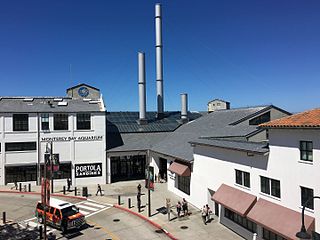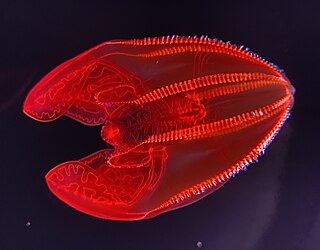
Monterey Bay Aquarium is a nonprofit public aquarium in Monterey, California. Known for its regional focus on the marine habitats of Monterey Bay, it was the first to exhibit a living kelp forest when it opened in October 1984. Its biologists have pioneered the animal husbandry of jellyfish and it was the first to successfully care for and display a great white shark. The organization's research and conservation efforts also focus on sea otters, various birds, and tunas. Seafood Watch, a sustainable seafood advisory list published by the aquarium beginning in 1999, has influenced the discussion surrounding sustainable seafood. The aquarium was home to Otter 841 prior to her release into the wild as well as Rosa, the oldest living sea otter at the time of her death.

The ocean sunfish or common mola is one of the largest bony fish in the world. It is the type species of the genus Mola, and one of five extant species in the family Molidae. It was once misidentified as the heaviest bony fish, which was actually a different and closely related species of sunfish, Mola alexandrini. Adults typically weigh between 247 and 1,000 kg. It is native to tropical and temperate waters around the world. It resembles a fish head without a tail, and its main body is flattened laterally. Sunfish can be as tall as they are long when their dorsal and ventral fins are extended.

The vampire squid is a small cephalopod found throughout temperate and tropical oceans in extreme deep sea conditions. The vampire squid uses its bioluminescent organs and its unique oxygen metabolism to thrive in the parts of the ocean with the lowest concentrations of oxygen. It has two long retractile filaments, located between the first two pairs of arms on its dorsal side, which distinguish it from both octopuses and squids, and places it in its own order, Vampyromorphida, although its closest relatives are octopods. As a phylogenetic relict, it is the only known surviving member of its order.

Larvaceans or appendicularians, class Appendicularia, are solitary, free-swimming tunicates found throughout the world's oceans. While larvaceans are filter feeders like most other tunicates, they keep their tadpole-like shape as adults, with the notochord running through the tail. They can be found in the pelagic zone, specifically in the photic zone, or sometimes deeper. They are transparent planktonic animals, usually ranging from 2 mm (0.079 in) to 8 mm (0.31 in) in body length including the tail, although giant larvaceans can reach up to 10 cm (3.9 in) in length.

The Monterey Bay Aquarium Research Institute (MBARI) is a private, non-profit oceanographic research center in Moss Landing, California. MBARI was founded in 1987 by David Packard, and is primarily funded by the David and Lucile Packard Foundation. Christopher Scholin serves as the institute's president and chief executive officer, managing a work force of approximately 220 scientists, engineers, and operations and administrative staff.

Lampocteis is a monotypic genus of comb jellies, the only genus in family Lampoctenidae. The sole species in this new genus is Lampocteis cruentiventer, the bloodybelly comb jelly. This ctenophore was first collected in the Pacific Ocean off the coast of San Diego, California, in 1979. It was described in 2001. The generic name was formed from the Ancient Greek lampós and kteís ("comb"), referring to the iridescence of its "combs"; the specific epithet was formed from the Latin cruentus ("blood-red") and venter ("belly"). Two morphological differences separating it from previously known comb jellies warranted the naming of a new family for this animal. These jellies are typically found at a depth of 250-1,500 meters deep in the North Pacific Ocean.

Gelatinous zooplankton are fragile animals that live in the water column in the ocean. Their delicate bodies have no hard parts and are easily damaged or destroyed. Gelatinous zooplankton are often transparent. All jellyfish are gelatinous zooplankton, but not all gelatinous zooplankton are jellyfish. The most commonly encountered organisms include ctenophores, medusae, salps, and Chaetognatha in coastal waters. However, almost all marine phyla, including Annelida, Mollusca and Arthropoda, contain gelatinous species, but many of those odd species live in the open ocean and the deep sea and are less available to the casual ocean observer. Many gelatinous plankters utilize mucous structures in order to filter feed. Gelatinous zooplankton have also been called Gelata.

Chrysaora colorata (Russell), commonly known as the purple-striped jelly or purple-striped sea nettle, is a species of jellyfish that exists primarily off the coast of California from Bodega Bay to San Diego. The bell (body) of the jellyfish is up to 70 cm (2.3 ft) in diameter, typically with a radial pattern of stripes. The tentacles vary with the age of the individual, consisting typically of eight marginal long dark arms, and four central frilly oral arms. It is closely studied by scientists due to not much being known about their eating habits. A 15-foot-long specimen has been seen.
Barbara Block is an American marine biologist and Charles & Elizabeth Prothro Professor of Biology in Marine Sciences at the Stanford University Hopkins Marine Station and a co-director of Stanford University's Tuna Research and Conservation Center, with the Monterey Bay Aquarium. She has published numerous bodies of work throughout her career in marine biology and chemistry, mainly focusing on the biology and chemistry of metabolism in different tuna and shark species. Additionally, she has helped develop two new types of electronic tags for large pelagic predators in order to track the migrations of large oceanic predator species.

Benthocodon is a genus of hydrozoans of the family Rhopalonematidae. The genus contains two known species: Benthocodon hyalinus and Benthocodon pedunculatus, however due to the small size and red pigmentation, they can easily be confused with related genera. Unlike many hydromedusae, these jellyfish do not have a sessile stage. Rather, they spend their entire lives in the water column as plankton. The genus Benthocodon can be found near the sea floor in the Pacific Ocean from Antarctica to California to the Arctic Ocean.
Free Ocean CO2 Enrichment (FOCE) is a technology facilitating studies of the consequences of ocean acidification for marine organisms and communities by enabling the precise control of CO2 enrichment within in situ, partially open, experimental enclosures. Current FOCE systems control experimental CO2 perturbations by real-time monitoring of differences in seawater pH between treatment (i.e. high-CO2) and control (i.e. ambient) seawater within experimental enclosures.

Histioteuthis heteropsis, known as the strawberry squid, is a species of small cock-eyed squid. The scientific nomenclature of these squid stems from their set of differently sized eyes, one being small and blue and the other being large and yellow. It is thought that the large eye is used to see objects against dim light, while the smaller eye is more able to view bioluminescent light sources. The squid's vernacular name arose due to its rich red skin pigmentation and the presence of photophores along its body, making it appear like a strawberry with seeds.

Thalassocalyce is a genus of ctenophore, or comb jellies, known from the California Coast, Gulf of Mexico, and west north Atlantic. It is represented by a single species, Thalassocalyce inconstans, which is the only species in the family Thalassocalycidae and the order Thalassocalycida. T. inconstans is a pelagic ctenophore typically occurring in upper-mesopelagic depths, but has been observed at depths up to 3,500 m in Monterey Canyon.
Kakani Katija is a bioengineer from Hawaii. While earning her Master's and PhD in Aeronautics and Bioengineering, Katija began to study the mechanics of swimming and feeding marine organisms.

Bathochordaeus, the giant larvaceans, is a genus of larvacean tunicates in the family Oikopleuridae. They are free-swimming filter-feeding marine animals that build mucus bubbles. They eat tiny particles of dead or drifting organic material that float through the water column, which contribute to the oceanic carbon cycle and the accelerated transfer of carbon to the deep sea.

Karen Joyce Osborn is a marine scientist at the Smithsonian's National Museum of Natural History Invertebrate Zoology department. She is known for her work in marine biology specializing in mid-water invertebrates.
Nanomia bijuga, first described by Stefano Delle Chiaje in 1844 and originally named Physsophora bijuga, is a species of mesopelagic siphonophore in the family Agalmatidae As with all members of the siphonophorae order, it is a colonial organism composed of individual zooids. N. bijuga has a fairly broad distribution, and has been observed in the coastal waters off of North America and Europe. The species has been found to occupy both epipelagic and mesopelagic depths. They utilize specialized swimming zooids for both propulsion and escape behaviors. Similar to other siphonophores, Nanomia bijuga employ stinging tentacles for hunting and defense. They primarily feed on small crustaceans, especially krill.
Bathochordaeus mcnutti, the blue-tailed giant larvacean, is a species of larvacean in the genus Bathochordaeus within the family Oikopleuridae. It's found in the North Pacific Ocean, it is comparatively large and reaching up to 10 centimeters in length including the tail. It can be distinguished from other giant larvaceans by its bright blue tail margin.
Fritillaria is a genus of larvacean tunicates belonging to the family Fritillariidae.
Mesochordaeus is a genus of oikopleurid larvacean, related to Bathochordaeus.













